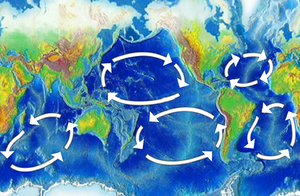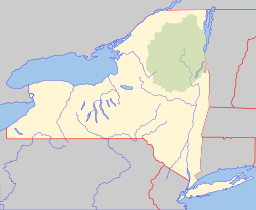인도양 쓰레기장
Indian Ocean garbage patch2010년 발견된 인도양 쓰레기매립지는 해양쓰레기 격인 해양쓰레기 패치로, 인도양 5대 해양쓰레기 중 하나인 인도양 세레(Gere)의 상층수기둥에 매달려 있다.[1][2][3][4][5][6] 이 패치는 연속적인 잔해 영역으로 나타나지 않는다. 5개의 해양 석유의 다른 조각들과 마찬가지로, 그 안에 있는 플라스틱들은 더 작은 입자들로 분해되고, 구성성 고분자로 분해된다.[7] 다른 패치들과 마찬가지로, 그 장은 펠라직 플라스틱, 화학적 슬러지 및 다른 파편들, 주로 육안으로는 보이지 않는 입자의 상승된 수준을 구성한다. 입자 파편의 농도는 평방 킬로미터당 약 1만 개의 입자로 추정되었다.[8][9][10][11]
디스커버리
가장 먼저 발견된 대태평양 쓰레기 지대의 존재는 미국 국립해양대기청(NOAA)이 발간한 1988년 논문에서 예견됐다. 이 예측은 1985년부터 1988년까지 알래스카에 기반을 둔 여러 연구자들이 북태평양에서 신소성 플라스틱을 측정한 결과에 근거한 것이었다.[12]
인도양과 주변 해변으로 씻겨진 쓰레기를 연구한 결과 인도양의 물기둥에서도 플라스틱이 발견될 수 있을 것으로 나타났다.[3]
이 악명 높은 쓰레기 더미에 중성적이고 긍정적인 부력의 플라스틱 물건들이 쌓이면서, 연구자들과 과학자들은 위험한 조류 때문에 그들의 위치를 정확히 알아내는 데 어려움을 겪고 있다.[13] 예를 들어, 서인도양 섬과 동부 아프리카 해안에 있는 아시아에서 수집된 쓰레기는 인도양을 가로질러 플라스틱 오염을 적도 해류를 통해 보낸다.[14] 비록 인도양 쓰레기 패치가 플라스틱 더미를 수집하여 해양 생물을 해치고 있지만, 연구자들과 과학자들은 또한 남태평양 쓰레기 더미, 북대서양 쓰레기 더미도 발견했다.[15] 불행하게도, 이러한 쓰레기 더미에서 수집된 약 90%의 쓰레기는 플라스틱으로 해양 생물들의 건강에 해로운 위협이다.[16] 플라스틱 쓰레기는 해안으로 모여들어 씻겨내려가 생물들의 건강에 영향을 미친다. 거센 조류 때문에 플라스틱 파편이 여러 곳에 해안으로 밀려와 환경 번영을 떨어뜨리고 생물에게 해를 끼친다.
2010년, 5 Gyres 프로젝트는 남대서양, 남태평양, 인도양 유정들이 북태평양 유정들과 같은 방식으로 영향을 받았는지를 결정하기 위해 계획된 일련의 대양 항해를 시작했다.[2][3][5][6] 인도양 구간에서 이들은 호주 퍼스와 마다가스카르 동쪽의 포트루이스(Port Louis)를 오갔다. 이들은 각각 플라스틱이 들어있는 4,800km(3,000mi)에서 채취한 물 샘플을 채취했다.[3] 그들은 남대서양, 남태평양, 인도양 석유가 북태평양 석유리와 같은 방식으로 영향을 받는다는 것을 발견했다.[2][3][5][6] 5 Gyres Institute의 공동 설립자인 Anna Cummins는 그들이 발견한 오염을 "가느다란 플라스틱 수프"[3]라고 불렀다.
원천
상위 10개 해양 플라스틱 오염원 중(중국이 30%로 전 세계 1위)인 인도양의 특징은 다음과 같다. 인도네시아(2위), 스리랑카(5위), 태국(6위), 말레이시아(8위), 방글라데시(10위).[17]
10개의 강은 바다에서 전체 플라스틱 오염의 90%를 차지한다. 이 중 2개는 인도양에 있다: 인더스호(대부분 플라스틱으로 세계 2위)와 갠지스호(6위)이다.[18][19]
인식 생성 작업
2013년 4월 11일, 예술가 마리아 크리스티나 피누치는 유네스코와 이탈리아 환경부의 후원 하에 열린 일련의 행사 중 첫 번째 행사인 이리나 보코바 국장 앞에서 유네스코[20] – 파리에 쓰레기 패치 주를 세웠다.[21]
참고 항목
참조
- ^ "Ocean Geography ~ MarineBio Conservation Society". Retrieved 17 September 2021.
- ^ Jump up to: a b c 남대서양 오염 사이트로의 첫 항해 SustainableBusiness.com 뉴스
- ^ Jump up to: a b c d e f 인도양, 로리 봉고르노, 그린 야후, 2010년 7월 27일 발견]
- ^ 의견: 섬은 플라스틱으로 오염된 바다를 위한 '자연 그물'이다. 2012년 10월 6일 웨이백 머신 마커스 에릭센(CNN, Peteral, CNN Tech, 2010년 6월 24일)에 보관된다.
- ^ Jump up to: a b c 우리의 바다 뒷마당: 플라스틱 바다 탐험 2010년 6월 20일 웨이백 머신에 보관된 Dan Haifley, 2010년 5월 15일 산타 크루즈 센티넬
- ^ Jump up to: a b c 2010년 11월 14일, 타임즈 라이브 플라스틱으로 인해 수생물이 막힘
- ^ Moore, Charles (November 2003). "Across the Pacific Ocean, plastics, plastics, everywhere". Natural History Magazine. Archived from the original on 6 July 2009.
- ^ Sesini, Marzia (August 2011). "The Garbage Patch In The Oceans: The Problem And Possible Solutions" (PDF). Columbia University.
- ^ 현재 샘플링 기법과 입자 크기에 대한 자세한 내용은 피터 라이언, 찰스 무어 외 연구진, 해양 환경에 플라스틱 파편이 많이 있는지 모니터링을 참조하십시오. 필, 트랜스 R. Soc. B 2009년 7월 27일 vol. 364 no. 1526 1999–2012, doi:10.1098/rstb.2008.0207
- ^ "Archived copy". Archived from the original on 14 February 2011. Retrieved 7 January 2011.CS1 maint: 제목으로 보관된 복사본(링크)
- ^ Transoceanic Traffic: 국제 및 미국의 대태평양 쓰레기 패치 전략, Susan L. Dautel, 3 Golden Gateway U. Envtl. L.J. 181 (2009)
- ^ Day, Robert H.; Shaw, David G.; Ignell, Steven E. (April 1988). "Quantitative distribution and characteristics of neustonic plastic in the North Pacific Ocean. Final Report to US Department of Commerce, National Marine Fisheries Service, Auke Bay Laboratory. Auke Bay, AK" (PDF). pp. 247–266.
- ^ Magazine, Hakai. "The Indian Ocean's Great Disappearing Garbage Patch". Hakai Magazine. Retrieved 22 September 2021.
- ^ Connan, Maëlle; Perold, Vonica; Dilley, Ben J.; Barbraud, Christophe; Cherel, Yves; Ryan, Peter G. (1 August 2021). "The Indian Ocean 'garbage patch': Empirical evidence from floating macro-litter". Marine Pollution Bulletin. 169: 112559. doi:10.1016/j.marpolbul.2021.112559. ISSN 0025-326X.
- ^ US Department of Commerce, National Oceanic and Atmospheric Administration. "Ocean Garbage Patches". oceanservice.noaa.gov. Retrieved 22 September 2021.
- ^ "Plane Search Shows World's Oceans Are Full of Trash". Science. 5 April 2014. Retrieved 22 September 2021.
- ^ Will Dunham (12 February 2019). "World's Oceans Clogged by Millions of Tons of Plastic Trash". Scientific American. Retrieved 31 July 2019.
China was responsible for the most ocean plastic pollution per year with an estimated 2.4 million tons, about 30 percent of the global total, followed by Indonesia, the Philippines, Vietnam, Sri Lanka, Thailand, Egypt, Malaysia, Nigeria and Bangladesh.
- ^ Christian Schmidt; Tobias Krauth; Stephan Wagner (11 October 2017). "Export of Plastic Debris by Rivers into the Sea". Environmental Science & Technology. 51 (21): 12246–12253. Bibcode:2017EnST...5112246S. doi:10.1021/acs.est.7b02368. PMID 29019247.
The 10 top-ranked rivers transport 88–95% of the global load into the sea
- ^ Harald Franzen (30 November 2017). "Almost all plastic in the ocean comes from just 10 rivers". Deutsche Welle. Retrieved 18 December 2018.
It turns out that about 90 percent of all the plastic that reaches the world's oceans gets flushed through just 10 rivers: The Yangtze, the Indus, Yellow River, Hai River, the Nile, the Ganges, Pearl River, Amur River, the Niger, and the Mekong (in that order).
- ^ "The garbage patch territory turns into a new state". unesco.org. UNESCO Office in Venice. 11 April 2013. Retrieved 20 April 2018.
- ^ "Rifiuti diventano stato, Unesco riconosce 'Garbage Patch'". www.rivistasitiunesco.it (in Italian). 14 July 2014. Archived from the original on 14 July 2014.
추가 읽기
- Gregory, M.R.; Ryan, P.G. (1997). "Pelagic plastics and other seaborne persistent synthetic debris: a review of Southern Hemisphere perspectives". In Coe, J.M.; Rogers, D.B. (eds.). Marine Debris: Sources, Impacts, Solutions. New York: Springer-Verlag. pp. 49–66.
- Masahisa Kubota; Katsumi Takayama; Noriyuki Horii (2000). "Movement and accumulation of floating marine debris simulated by surface currents derived from satellite data" (PDF). School of Marine Science and Technology, Tokai University.
외부 링크
- 태평양 쓰레기 패치 – 스미스소니언 오션 포털
- "플라스틱 서핑" 완구와 포장의 건강하지 못한 사후세계: 작은 장난감, 병, 포장재가 바다에 남아 해양 생물과 어쩌면 2010년 8월 제니퍼 애커먼 사이언티픽 아메리칸에 의해 우리까지 피해를 입힐 수도 있다.
- 세계에서 가장 큰 쓰레기 덩어리의 영향을 기록하기 위해 최근 태평양의 외딴 지역으로 여행한 사진작가 크리스 조던. Seed CS1 maint: 잘못된 URL(링크)
- SEAPLEX (Spic Eprovement of Synthetic Escription, SEAPLEX) – Scripps Institute of Oceanography, UC 샌디에이고
- 프로젝트 카이세이 항해 추적기 – 프로젝트 카이세이 및 오진골랍스
- 5 Geres – 플라스틱 해양 오염 이해 – Algalita, 살기 좋은 유산
- 쓰레기 소용돌이 그린피스
- 태평양의 '쓰레기 패치' 항해 – National Public Radio and me
- 해양 연구, 교육 및 복원 – 알갈리타 해양 연구 재단
- 북태평양 지역의 이미지 & 비디오 – WordPress.com
- Sea of Trash – New York Times 매거진
- 플라스틱 바다에 있는 찰스 무어 선장
- Charles Moore: 그레이트 퍼시픽 쓰레기장 항해 – TED 컨퍼런스 토크(2009)



